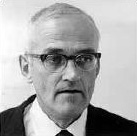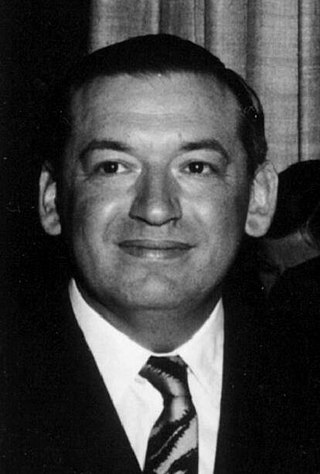Related Research Articles

Clair Cameron Patterson was an American geochemist. Born in Mitchellville, Iowa, Patterson graduated from Grinnell College. He later received his Ph.D. from the University of Chicago and spent his entire professional career at the California Institute of Technology (Caltech).
Grenville Turner is a research professor at the University of Manchester. He is one of the pioneers of cosmochemistry.

Don Lynn Anderson was an American geophysicist who made significant contributions to the understanding of the origin, evolution, structure, and composition of Earth and other planets. An expert in numerous scientific disciplines, Anderson's work combined seismology, solid state physics, geochemistry and petrology to explain how the Earth works. Anderson was best known for his contributions to the understanding of the Earth's deep interior, and more recently, for the plate theory hypothesis that hotspots are the product of plate tectonics rather than narrow plumes emanating from the deep Earth. Anderson was Professor (Emeritus) of Geophysics in the Division of Geological and Planetary Sciences at the California Institute of Technology (Caltech). He received numerous awards from geophysical, geological and astronomical societies. In 1998 he was awarded the Crafoord Prize by the Royal Swedish Academy of Sciences along with Adam Dziewonski. Later that year, Anderson received the National Medal of Science. He held honorary doctorates from Rensselaer Polytechnic Institute and the University of Paris (Sorbonne), and served on numerous university advisory committees, including those at Harvard, Princeton, Yale, University of Chicago, Stanford, University of Paris, Purdue University, and Rice University. Anderson's wide-ranging research resulted in hundreds of published papers in the fields of planetary science, seismology, mineral physics, petrology, geochemistry, tectonics and the philosophy of science.
Samuel Epstein was a Canadian-American geochemist who developed methods for reconstructing geologic temperature records using stable isotope geochemistry. He was elected to the United States National Academy of Sciences in 1977, and a fellow of the Royal Society of Canada in 1997.
Harmon Craig was an American geochemist who worked briefly for the University of Chicago (1951-1955) before spending the majority of his career at Scripps Institution of Oceanography (1955-2003).

Heinz Adolf Lowenstam was a German-born, Jewish-American paleoecologist celebrated for his discoveries in biomineralization: that living organisms manufacture substances such as the iron-containing mineral magnetite within their bodies. He is also renowned for his pioneering research on coral reefs and their influence on biologic processes in the geologic record.

Leon Theodore Silver was an American geologist who was professor of geology at the California Institute of Technology (Caltech). He was an instructor to the Apollo 13, 15, 16, and 17 astronaut crews. Working with the National Aeronautics and Space Administration (NASA), he taught astronauts how to perform field geology, essentially creating lunar field geology as a new discipline. His training is credited with a significant improvement in the J-Mission Apollo flights' scientific returns. After the Apollo program, he became a member of the United States National Academy of Sciences in 1974. He retired as the W. M. Keck Foundation Professor for Resource Geology, emeritus, at Caltech.

Jacob Bigeleisen was an American chemist who worked on the Manhattan Project on techniques to extract uranium-235 from uranium ore, an isotope that can sustain nuclear fission and would be used in developing an atomic bomb but that is less than 1% of naturally occurring uranium. While the method of using photochemistry that Bigeleisen used as an approach was not successful in isolating useful quantities of uranium-235 for the war effort, it did lead to the development of isotope chemistry, which takes advantage of the ways that different isotopes of an element interact to form chemical bonds.

Donald James DePaolo is an American professor of geochemistry in the department of earth and planetary science at the University of California, Berkeley and associate laboratory director for energy and environmental sciences at the Lawrence Berkeley National Laboratory.

Sir Alexander Norman Halliday is a British geochemist and academic who is the Founding Dean of the Columbia Climate School, and Director of the Earth Institute at Columbia University. He joined the Earth Institute in April 2018, after spending more than a decade at the Department of Earth Sciences at the University of Oxford, during which time he was dean of science and engineering. He is also a professor of Earth and Environmental Sciences at Columbia University.
Harrison Scott Brown was an American nuclear chemist and geochemist. He was a political activist, who lectured and wrote on the issues of arms limitation, natural resources and world hunger.
Francis Albarède is a French geochemist. He is Professor at the Ecole Normale Superieure de Lyon and a member of the Academia Europaea. In January 2011, he became the first director of the Laboratory of Geology Lyon (UMR5276).
Kliti Grice, is a chemist and geochemist known for her work in identifying geological and environmental causes for mass extinction events. Her research integrates geological information with data on molecular fossils and their stable carbon, hydrogen and sulfur isotopic compositions to reconstruct details of microbial, fungal and floral inhabitants of modern and ancient aquatic environments and biodiversity hot spots. This information expands our understanding of both the Earth's history and its current physical state, with implications ranging from energy and mineral resource exploration strategies to environmental sustainability encompassing climate dynamics and expected rates, durations and scale of our future planet's health. As one of the youngest women professors in Earth Sciences, she is the founding director of the Western Australian Organic and Isotope Geochemistry Centre (WA-OIGC) and is a Professor of Organic and Isotope Geochemistry at Curtin University in Perth, Western Australia.

Janne Blichert-Toft is a geochemist, specializing in the use of isotopes with applications in understanding planetary mantle-crust evolution, as well as the chemical composition of matter in the universe. To further this research, Blichert-Toft has developed techniques for high-precision Isotope-ratio mass spectrometry measurements.
Sethunathasarma Krishnaswami (1945–2015), popularly known as Swami, was an Indian geochemist and an honorary scientist at the geosciences division of the Physical Research Laboratory. He was known for his studies on low temperature geochemistry and was an elected fellow of the Indian Academy of Sciences, Indian National Science Academy, The World Academy of Sciences, National Academy of Sciences, India, American Geophysical Union, Geochemical Society and European Association of Geochemistry (2003). The Council of Scientific and Industrial Research, the apex agency of the Government of India for scientific research, awarded him the Shanti Swarup Bhatnagar Prize for Science and Technology, one of the highest Indian science awards for his contributions to Earth, atmosphere, ocean and planetary Sciences in 1984.
Sunil Kumar Singh is a leading Indian geochemist, a former professor at the Physical Research Laboratory and currently the director of the National Institute of Oceanography, India. He is known for his studies on low temperature elemental and isotope geochemistry and his researches are reported to have assisted in widening the understanding of the evolution of the Himalayas. His studies have been documented in several peer-reviewed articles; Google Scholar, an online repository of scientific articles, has listed 99 of them respectively.
Edward Bruce Watson is an American geochemist at Rensselaer Polytechnic Institute in Troy, New York.
T. Kurtis (Kurt) Kyser was an American and Canadian geologist and geochemist, Fellow of the Royal Society of Canada, professor of the University of Saskatchewan and Queen's University, founder and director of the Queen's Facility for Isotope Research (QFIR). Kyser served as a president of the Mineralogical Association of Canada and as an Editor-in-Chief of the journal Geochemistry: Exploration, Environment, Analysis (GEEA).
Stanley Robert Hart is an American geologist, geochemist, leading international expert on mantle isotope geochemistry, and pioneer of chemical geodynamics.
T. Mark Harrison is an isotope geochemist based in California. He is Distinguished Professor of Geochemistry in the Department of Earth, Planetary and Space Sciences, University of California – Los Angeles.
References
- 1 2 "Kenneth A. Farley, Caltech, Home page" . Retrieved 2009-02-08.